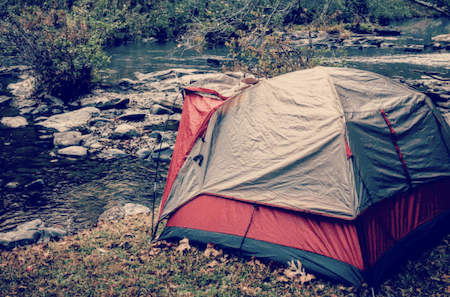It’s often impossible to detect the weather when planning for your next camping trip.
A sunny day can turn gloomy all of a sudden without much warning. And before you know it may be pouring all over your campground and ruin your whole setup.
So, you need to take some precautions to save your day and your tent from bad weather.
Knowing that your tent will remain dry and warm, you can rest easy with a rain fly in place.
The rain fly will protect your tent to keep you safe from the cold during rain and snow.
Here’s everything you should know about how to make a rain fly for tent that can come in handy for your next camping trip.
What Is A Rain Fly?
A rain fly is a separate cover that goes over the tent to keep it dry. It’s an integral part of a tent that helps a lot in camping.
This multi-purpose component is water-resistant, and it’s often your only protection against the pitter-patter of the rain trying to hit your tent.
Many double-walled tents come with mesh ceilings. The mesh ceiling is a lifesaver in warm weather since it helps to circulate air into the tent.
The temperature inside the tent is well-maintained, thanks to the breathable mesh.
We often prefer camping to stay away from the hustle-bustle of the city. Connecting with nature and enjoying the elements with them is a great way to unwind.
Many campers prefer stargazing, especially when they are out in the summer. The mesh ceiling of a tent also helps with stargazing.
But the downside of the mesh ceiling arises when it rains or during the winter.
The rain, snow, and cold can ruin your camping instantly. This is why rain fly is necessary.
It can ensure your camping experience will not be ruined no matter where you camp or the weather.
How To Make A Rain Fly For Tent
Most tents come with their rain fly. If your tent is missing one, you can make your own rain fly.
Making a rain fly instead of buying one can save you a lot of money.
Also, you can get a perfectly customized rain fly for your tent that will fit properly.
Now, let’s discuss how to make a rain fly for tent.
#1. Get The Right Materials
- Tarp
- Fabric
Tarp is one of the most common materials used to make a rain fly. There are different types of tarps to choose from.
You can make a rain fly out of any one of these tarps. There are canvas tarps that come with oil and wax coating on the surface.
They are great for keeping water and moisture away from the tent.
Then, you have tarps made out of polyethylene. You can probably find blue poly tarps often since they are so cheap.
Poly tarps are not the most durable, but also are suitable for a quick rain fly solution. There are also PVC tarps and polyester tarps to choose from.
Other than a tarp, fabrics are also used to make a rain fly. You can use waterproof fabrics or reinforced fabrics that are water-resistant.
We highly recommend getting durable fabrics so that the rain fly will not tear after encountering heavy rainfall.
#2. Choose The Appropriate Size
The size of your rain fly depends on personal preference. Your tent of choice will undoubtedly play a role, but you can make some tweaks.
You can size the rain fly to cover only the tent or leave some extra space on the sides.
You can also size the rain fly so it will add a canopy out front after covering the tent.
You can leave a foot or several feet of extra space in front of the tent.
#3. Securing The Rain Fly
Now, it’s time to secure the rain fly to the tent. You can use grommets to secure the rain fly by adding them after every couple of feet.
Or, you can make sure you have enough rope to connect the rain fly to the tent poles if you’re using cord and tent posts.
You should have a sturdy, waterproof cord if you’re attaching the rain fly directly to the trees around the tent.
You can use braided poly ropes, which are mold and UV-resistant.
They are an excellent choice for a tie-down that will not decay when exposed to moisture.
What To Consider While Setting Up Your Tent
Now that we’ve discussed how to make a rain fly for tent, we’ll also cover what you should keep in mind while setting up your tent.
Tight Seams
Even with a rain fly over the tent, rainwater or dew can still get inside a tent if it has poor seams.
Avoid getting cheap or bad tents since they are likely to have the weakest seams.
Even if you have a good tent, consider using a seam sealer to prevent any water or moisture from getting inside.
Ground Cloth
A tarp or something similar can be used as a ground cloth before setting up a tent.
A ground cloth is the floor of your tent where you will be staying.
If the ground cloth is too big, it will have access cloth peeking out of the tent or the rain fly coverage.
When the rainwater hits the rain fly, some droplets can accumulate on the outer surface and trickle down.
If you have a ground cloth sticking out of the tent, the collected rainwater can seep into the ground cloth.
That will cause the ground cloth to get wet and make the inside of your tent cold.
Tent Set-Up
If you have a tent with faulty set-up strategies, it’s quite possible that it won’t save you from rain.
However, if you have a good tent (complete with a rain fly), it can still fail to save you from the rain if you do not know how to set it up properly.
Many campers, especially those with little or no experience, end up being soaked since their attempts at setting up a tent are pretty poor.
Find a good spot to set up your tent and do it right.
Waterproof Spray
A lot of spray-on waterproofing solutions are available on the market. These spray-ons are an excellent way to increase the water-resistant power.
You can even apply one of those sprays on the tent or rain fly fabric.
You can use a sponge or brush to apply the spraying solution perfectly. It will help keep any moisture off the surface.
Remember to keep an extra cloth on hand to wipe off any excess waterproofing product when applying it.
Frequently Asked Questions
Do I Really Need A Rain Fly For Camping?
Yes. If your tent does not come with a rain fly, you need to take one with you.
Many tents have open roofs or mesh ceilings which can be problematic if the sky is cloudy.
It is better to have a rain fly at hand to avoid rainwater dribbling down your face in your sleep.
How Can I Attach A Rain Fly To A Tent?
You can use ropes, hooks, or cords to attach the rain fly to a tent.
Just attach the rain fly with the tent frame to ensure it stays in place.
Should I Put A Tarp Under A Tent?
Having a ground covering or tarp under the tent is vital for durability. Especially, if you are pitching the tent on gravel. Also, it can keep you extra warm.
But if the tarp is too big, it can collect moisture and pool beneath the tent.
While camping outside, place a tarp inside your tent instead of beneath it.
Why Is My Tent Leaking?
You can have a good rain fly in place, and your tent can still leak, especially during the monsoon.
Water can go through the micro-pores of a tent fabric when it is raining too heavily.
Faulty seams of a tent can also cause water to seep inside and make it wet.
Why Is My Rain Fly Getting Moldy?
Your rain fly can get moldy if it is not getting enough sunlight.
If your rain fly comes in contact with any moisture, make sure you wipe it off and dry it properly.
Keep the rain fly in an airtight bag when it is not in use.
Can I Use A Tent Without Rain Fly?
Yes, but it isn’t recommended.
Many manufacturers make tents with a very short rain fly or with no rain fly.
These tents are not waterproof and are not suitable for any weather other than summer.
You need a waterproof camping tent for all weather.
A waterproof tent will come with a rain fly or are at least double-walled with polyester to keep the rain at bay.
If your tent does not come with a rain fly, consider using a makeshift one.
Final Words
Making a rain fly is quite simple. All you need is patience and a basic idea of what to do.
Now that you know how to make a rain fly for tent, it should come in handy while you are camping.
If you get a tent without a rain fly, you can make one yourself.
No matter where you go camping, keeping a tarp with your camping gear is a good idea.
You never know when the weather will turn for the worse, so you need to be ready.
If you have the materials required to make a rain fly, you won’t have to worry about the weather at the campground.
Happy camping!


